The History Of Cart Building, Parts I & II
Part I
I've needed some sort of cart ever since I moved here: for hauling groceries and laundry, for hauling debris out of the garden, and for hauling things home from skips.
I've not had the money to buy a proper cart, wagon or bike trailer, so I've improvised various things over the years. So far they've all suffered from two problems: the wheels are too small to roll smoothly along tarmac or gravel, and none of the frames have been sturdy enough to carry heavy loads.
A year ago I saw two kiddy bikes in a skip and took the wheels off, thinking these would be ideal for rolling over roads. Problem was that I didn't have a frame to hang them off. I needed an axle that would connect both wheels and span whatever cart frame I had, or I needed a rigid U-shaped brace to slot each wheel into; a brace that I could then bolt to a box/frame.
I've yet to see a suitable axle. I need something 2 or 3 feet wide. 60-100cm. No such luck.
As for a brace, I am pretty sure I could get a blacksmith/metal fabricator to bend a piece of steel for me, but I have yet to find one in any of my travels. In a town that once had metal-bashers in almost every neighbourhood, it's disappointing to go for so long without seeing one. It would be a ten minute job and I'd gladly pay a few quid for it.
Every once in a while I have an immediate need for a haulage-type contraption and set about improvising again. Today I decided to haul some bags of rubble from the bottom of the garden, but they were to heavy to carry, so I decided I'd try to improvise something with the bicycle wheels.
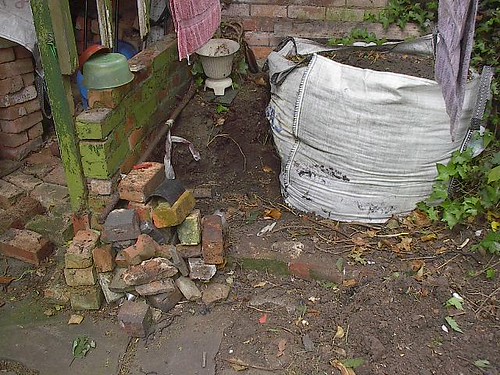
The Garden Debris
In with the garden debris was a bit of tubing from a playframe and I thought I could bend it into a U-shape, flatten the ends, drill a hole in each end, then bolt it to the wheels. The thing would have collapsed under the weight, with the wheel camber going all out of alignment, but I might get the bags moved before that happened.
While I was fiddling with the wheels, I realised that the tube could simply be jammed onto the axles, and that if I spread the weight with a board, it wouldn't collapse quite so soon. The wheels could simply fall off, working their way loose from the tube-ends, but again, they might stay in long enough to get the job done.
So here are the photos of the work in progress, and the successfully moved bags of rubble. You see the tube, and how thin it is, plus the fact that it fits snugly over the axle and nuts. I used the existing holes along the tube to bolt a small piece of chip-board, which in turn hold a broom handle.

Axle Jamming

Chassis

Load Distribution
All it needs now is some air in the tires. I'm not sure where my pump is, so I wheeled the rubble sacks with the tires flat. I was mostly travelling over lawn and up a gravel slope, so it wasn't that hard on the tires. One wheel worked itself part-way loose, so it's obvious that this cart will not be going on any shopping, laundry, or junk collecting excursions. I need some sturdier way of attaching the wheels to a frame for any of that. But the garden is now almost rubble-free - just a few bricks and branches left to clear away.
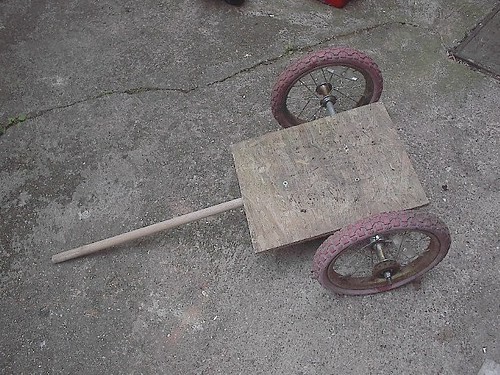
Job Done

Sack O' Rocks
Part II
Having given you the low-down on the latest contraption, I figure it's a good time to give the back-story as well, covering the previous three attempts to build a cart. Might as well run the gamut so you can see the lengths I've gone to, and either marvel or cringe at the Heath Robinson/Rube Goldberg qualities of my work.
The first cart was nearly the best one, consisting of a discarded post office sorting basket, some shopping trolley wheels, and the handle from a broken fly-mower. I had ambitions to paint it with three hues of Hammerite, but it had an accident that hasn't been repaired, so the color scheme is on hold.
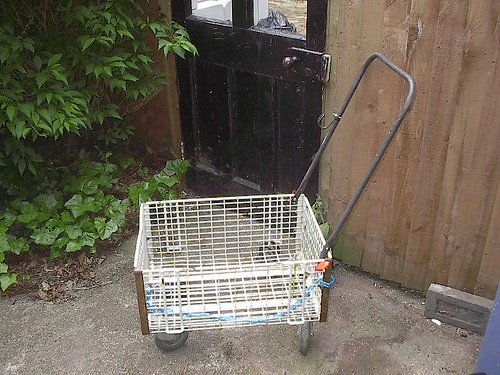
Cart No. 1
This one worked until I put something very heavy on it and one of the wheels buckled. This is because the wheels are clamped to the wire frame, and the wire twisted under pressure. If I had a metal plate in the bottom of the basket - or even four smallish metal plates - the problem would be solved. But where does one buy iron/steel plate these days? Not around here. If this were Portland or Berkeley I'd know where to go.
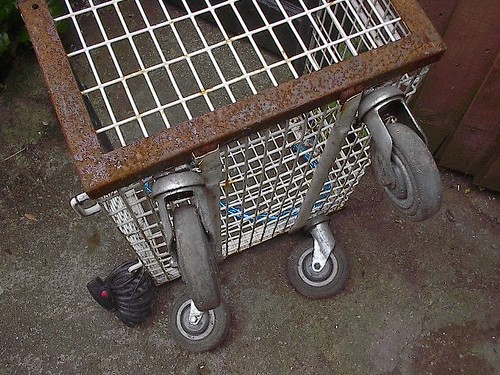
Wheel Strain
The second cart was an improvised luggage carrier made from a few sticks, a bit of shelving, the training-wheels off a kid's bike, a metal strap and a piece of garden hose. I used it twice, to haul a flight bag full of laundry the half-kilometre to the laundromat. The bag didn't stay on so well, and the tiny wheels made rough going. I gave up on that one.
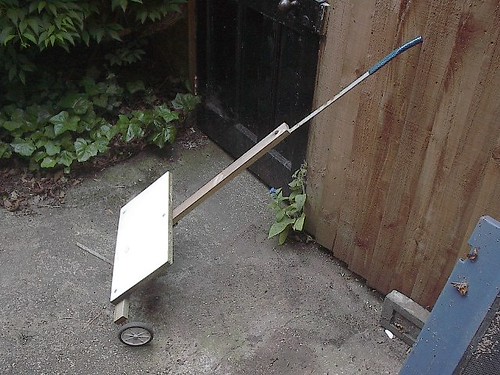
Cart No. 2
The third one was not something I modified. I scavenged a golf-bag cart from a skip, and set to work moving some Hebel blocks I'd scavenged from an art project. It collapsed under the weight of a long block. You can see how the little footplate is twisted. So I dismantled it and set it aside for future efforts.
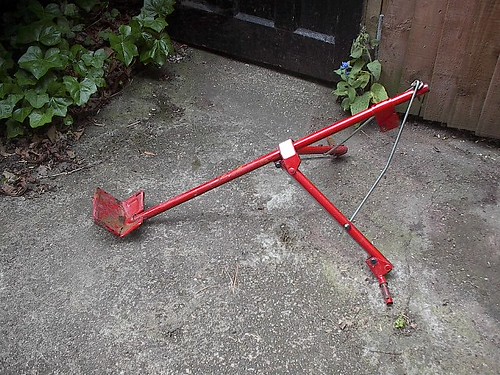
Cart No.3 - Cannibalised
The block has Unten written on it, upside down.

Hebel Block
The cart was not made for such work, though it performed quite well at first. I have kept the frame, thinking that I could add other wheels, reinforce it somehow, and make it into a scavenging vehicle. I think the tubing is sturdy enough to carry something heavy like a washing machine. I am still looking for a washing machine...
Finally, a few weeks ago at Lidl - the cut-price supermarket - some shopping carts with detachable canvas bag showed up for about £8, so I bought one. These are essentially luggage trolleys with a removable sack. I have used it twice, to carry laundry. But even these wheels are too small and hard, making it awkward to go up and down the kerbs and along the tarmac. I would not trust this frame with anything heavy.
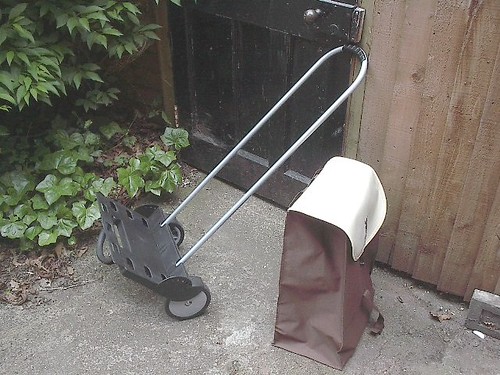
Cart No. 4
So this is the history of cart-building so far. I would like to get the bicycle wheels onto something sturdy enough to carry timbers, blocks, furniture and machinery. If I had ten feet of angle iron, I would cut it and bolt it together as a narrow rectangle, then put the bicycle wheels toward the rear and give myself a long pair of handles. I would be happy to walk some distance if I had a truly sturdy and smooth-rolling cart. It would be great to have a bicycle cart, but that would still be a problem for moving large and heavy things. Actually, add a wheelbarrow or garden cart to that list. Looks like my carting needs are sufficiently diverse that I need two, three, four?

